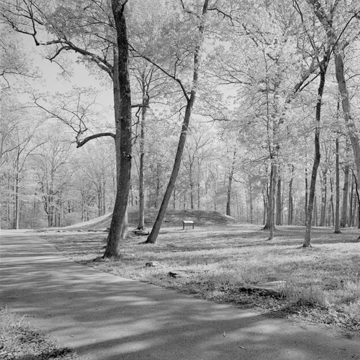Prehistoric mound-building is a practice seen throughout North America, and perhaps most famously at the Cahokia site in Collinsville, Illinois, and Poverty Point in northeast Louisiana. The Mississippi River basin hosts thousands of these mounds, including the Shiloh Indian Mounds, located on an elevated tableland above the Tennessee River. The site, also renowned as a Civil War battlefield, contains at least seven mounds and the remnants of nearly one hundred buildings. Archaeological excavations revealed that a perimeter palisade protected this complex, built from timber posts and potentially infilled with clay. The 22-hectare complex was arranged around a centralized plaza.
The site is dated to around 1100–1300, or some 800 years ago, and belonged to a chiefdom society that occupied the Tennessee River Valley. According to the National Park Service, which currently maintains the Shiloh Mounds, the inhabitants were farmers, and grew crops such as maize, squash, and sunflowers, while hunting foodstuffs such as deer, turkey, and fish.
Of the mounds at the site, six are rectangular in form with a flattened top, suggesting that these acted as platforms for other structures such as council houses or dwellings. One of the mounds, a burial place, is oval and rounded. Archaeological work at the site began as early as 1867, and includes C. B. Moore’s 1914 mapping and measuring of the mounds; the largest earthwork, Mound A, rises 14 feet 6 inches while the lowest, Mound E, rises 5 feet 1 inch. An excavation conducted by the Civil Works Administration in 1933 revealed the remains of squat piles, about 1 foot tall, which researchers suggest are the remnants of wattle-and-daub structures. These were built from wall posts enclosing spaces that ranged from 10 to 20 feet, each with a fireplace centered within. Because mowing is not allowed, Shiloh is one of the few sites that has retained the remains of such structures. The palisade barrier was also built from upright, closely set posts.
As recent geo-archaeological research suggests, earthen mounds such as Shiloh should rightly be deemed monumental designs, as soil and sediment evaluation suggests that a level of sophistication was required to build these forms. Pre-Columbian skills included a familiarity with soil, engineering, and the processes of construction, not to mention access to skilled labor. At Shiloh, differing soils were deliberately intermixed, while sod blocks lined the mound’s embankment, the entirety of which was finished with a red veneer. Mound-building, as Shiloh itself suggests, was not a process of merely piling up earth but rather a thoughtful, deliberate, and social act intended to communicate something about its society.
The Shiloh Indian Mounds are part of the larger Shiloh National Military Park and are maintained by the National Park Service. The Visitor Center includes space for exhibits and special programs, as well as information and maps for the interpretative trail around the mounds.
References
Anderson, David G., et al. Archeological Investigations at Shiloh Indian Mounds National Historic Landmark (40HR7): 1999–2004. Tallahassee, FL.: U.S. Department of the Interior, National Park Service, Southeast Archeological Center, 2013.
National Park Service. "Shiloh Indian Mounds." Accessed 13 June 2017. https://www.nps.gov/shil/learn/historyculture/upload/Mounds.pdf
Sherwood, Sarah C., and Tristram R. Kidder. "The DaVincis of Dirt: Geoarchaeological Perspectives on Native American Mound Buildings in the Mississippi River Basin." Journal of Anthropological Archaeology 30, issue 1 (March 2011): 69–87.
Welch, Paul D. Archaeology at Shiloh Indian Mounds. Tuscaloosa: University of Alabama Press, 2006.

